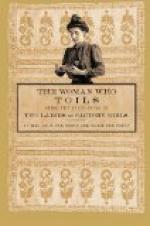Board, lodging, heat and light we could have at $2.75 a week. Before the husky clock had struck twelve, I was installed in a small room with the middle-aged woman from Batavia and a second unknown roommate.
Now what, I asked myself, is the mill’s attraction and what is the power of this small town? Its population is 3,346. Of these, 1,000 work in the knitting-mill, 200 more in a cutlery factory and 300 in various flour, butter, barrel, planing mills and salt blocks. Half the inhabitants are young hands. Not one in a hundred has a home in Perry; they have come from all western parts of the State to work. There are scarcely any children, few married couples and almost no old people. It is a town of youthful contemporaries, stung with the American’s ambition for independence and adventure, charmed by the gaiety of being boys and girls together, with an ever possible touch of romance which makes the hardest work seem easy. Within the four board walls of each house, whose type is repeated up and down Perry streets, there is a group of factory employees boarding and working at the mill. Their names suggest a foreign parentage, but for several generations they have mingled their diverse energies in a common effort which makes Americans of them.
As I lived for several weeks among a group of this kind, who were fairly representative, I shall try to give, through a description of their life and conversation, their personalities and characteristics, their occupations out of working hours, a general idea of these unknown toilers, who are so amazingly like their more fortunate sisters that I became convinced the difference is only superficial—not one of kind but merely of variety. The Perry factory girl is separated from the New York society girl, not by a few generations, but by a few years of culture and training. In America, where tradition and family play an unimportant part, the great educator is the spending of money. It is through the purchase of possessions that the Americans develop their taste, declare themselves, and show their inherent capacity for culture. Give to the Perry mill-hands a free chance for growth, transplant them, care for them, and they will readily show how slight and how merely a thing of culture the difference is between the wild rose and the American beauty.




